Neurogastronomy as a Tool for Evaluating Emotions and Visual Preferences of Selected Food Served in Different Ways
Abstract
1. Introduction
2. Materials and Methods
- -
- Matlab R2019a,
- -
- Mathematical-statistical program R,
- -
- Microsoft excel 2010.
3. Results
4. Discussion
5. Conclusions
Author Contributions
Funding
Institutional Review Board Statement
Informed Consent Statement
Data Availability Statement
Conflicts of Interest
References
- Piqueras-Fiszman, B.; Alcaide, J.; Roura, E.; Spence, C. Is it the plate or is it the food? Assessing the influence of the color (black or white) and shape of the plate on the perception of the food placed on it. Food Qual. Prefer. 2012, 24, 205–208. [Google Scholar] [CrossRef]
- Reisfelt, H.H.; Gabrielsen, G.; Aaslyng, M.D.; Bjerre, M.S.; Møller, P. Consumer preferences for visually presented meals. J. Sens. Stud. 2009, 24, 182–203. [Google Scholar] [CrossRef]
- Velasco, C.; Michel, C.; Woods, A.T.; Spence, C. On the importance of balance to aesthetic plating. Int. J. Gastron. Food Sci. 2016, 5–6, 10–16. [Google Scholar] [CrossRef]
- Zellner, D.A.; Loss, C.R.; Zearfoss, J.; Remolina, S. It tastes as good as it looks! The effect of food presentation on liking for the flavor of food. Appetite 2014, 77, 31–35. [Google Scholar] [CrossRef]
- Michel, C.; Velasco, C.; Gatti, E.; Spence, C. A taste of Kandinsky: Assessing the influence of the artistic visual presentation of food on the dining experience. Flavour 2014, 3, 1–11. [Google Scholar] [CrossRef]
- Michel, C.; Velasco, C.; Fraemohs, P.; Spence, C. Studying the impact of plating on ratings of the food served in a naturalistic dining context. Appetite 2015, 90, 45–50. [Google Scholar] [CrossRef] [PubMed]
- Stasi, A.; Songa, G.; Mauri, M.; Ciceri, A.; Diotallevi, F.; Nardone, G.; Russo, V. Neuromarketing empirical approaches and food choice: A systematic review. Food Res. Int. 2018, 108, 650–664. [Google Scholar] [CrossRef] [PubMed]
- Lahne, J. Neurogastronomy: How the Brain Creates Flavors and Why it Matters: By Gordon M. Shepherd. Food Cult. Soc. 2013, 16, 327–330. [Google Scholar] [CrossRef]
- Berčík, J.; Mravcová, A.; Gálová, J.; Mikláš, M. The use of consumer neuroscience in aroma marketing of a service company. Potravin. Slovak J. Food Sci. 2020, 14, 1200–1210. [Google Scholar]
- Alvino, L.; Pavone, L.; Abhishta, A.; Robben, H. Picking Your Brains: Where and How Neuroscience Tools Can Enhance Marketing Research. Front. Neurosci. 2020, 14. [Google Scholar] [CrossRef]
- Niedziela, M.M.; Ambroze, K. The future of consumer neuroscience in food research. Food Qual. Prefer. 2020. [Google Scholar] [CrossRef]
- Horská, E.; Berčík, J. Neuromarketing in Food Retailing; Wageningen Academic Publishers: Wageningen, The Netherlands, 2017; p. 85. [Google Scholar]
- Zhang, B.; Seo, H.S. Visual attention toward food-item images can vary as a function of background saliency and culture: An eye-tracking study. Food Qual. Prefer. 2015, 41, 172–179. [Google Scholar] [CrossRef]
- Seo, H.S.; Roidl, E.; Müller, F.; Negoias, S. Odors enhance visual attention to congruent objects. Appetite 2010, 54, 544–549. [Google Scholar] [CrossRef] [PubMed]
- Orquin, J.L.; Holmqvist, K. Threats to the validity of eye-movement research in psychology. Behav. Res. Methods 2018, 50, 1645–1656. [Google Scholar] [CrossRef]
- Mengual-Recuerda, A.; Tur-Viñes, V.; Juárez-Varón, D. Neuromarketing in Haute Cuisine Gastronomic Experiences. Front. Psychol. 2020, 11, 1772. [Google Scholar] [CrossRef]
- Wang, G.J.; Volkow, N.D.; Telang, F.; Jayne, M.; Ma, J.; Rao, M.; Zhu, W.; Wong, C.T.; Pappas, N.R.; Geliebter, A.; et al. Exposure to appetitive food stimuli markedly activates the human brain. Neuroimage 2004, 21, 1790–1797. [Google Scholar] [CrossRef]
- Horská, E.; Berčík, J.; Krasnodebski, A.; Matysik-Pejas, R.; Bakayova, H. Innovative approaches to examining consumer preferences when choosing wines. Agric. Econ. (Czech Republic) 2016, 62, 124–133. [Google Scholar] [CrossRef]
- Muñoz-Leiva, F.; Gómez-Carmona, D. Sparking interest in restaurant dishes? Cognitive and affective processes underlying dish design and ecological origin. An fMRI study. Physiol. Behav. 2019, 200, 116–129. [Google Scholar] [CrossRef]
- Wolfe, K.; Jo, W.M.; Olds, D.; Asperin, A.; DeSanto, J.; Liu, W.C. An fMRI Study of the Effects of Food Familiarity and Labeling on Brain Activation. J. Culin. Sci. Technol. 2016, 14, 332–346. [Google Scholar] [CrossRef]
- Yasui, Y.; Tanaka, J.; Kakudo, M.; Tanaka, M. Relationship between preference and gaze in modified food using eye tracker. J. Prosthodont. Res. 2019, 63, 210–215. [Google Scholar] [CrossRef] [PubMed]
- Helmert, J.R.; Symmank, C.; Pannasch, S.; Rohm, H. Have an eye on the buckled cucumber: An eye tracking study on visually suboptimal foods. Food Qual. Prefer. 2017, 60, 40–47. [Google Scholar] [CrossRef]
- Bailey, R.A. Design of Comparative Experiments; Cambridge University Press: New York, NY, USA, 2008; 330p. [Google Scholar]
- Goldberg, J.H.; Wichansky, A.M. Eye Tracking in Usability Evaluation. A Practitioner’s Guide. In The Mind’s Eye: Cognitive and Applied Aspects of Eye Movement Research; Hyönä, J., Radach, R., Deubel, H., Eds.; North-Holland: Amsterdam, The Netherlands, 2003; pp. 493–516. ISBN 9780444510204. [Google Scholar]
- Nagel, C. Sample Size in Neuromarketing. Neuromarketing Theory Pract. 2014, 9, 6–9. [Google Scholar]
- Hensel, D.; Iorga, A.; Wolter, L.; Znanewitz, J. Conducting neuromarketing studies ethically-practitioner perspectives. Cogent Psychol. 2017, 4, 1–13. [Google Scholar] [CrossRef]
- Madipakkam, A.R.; Bellucci, G.; Rothkirch, M.; Park, S.Q. The influence of gaze direction on food preferences. Sci. Rep. 2019, 9, 1–9. [Google Scholar] [CrossRef] [PubMed]
- Code of Ethics of Laboratory of Consumer Studies FEM SUA in Nitra. Available online: http://www.fem.uniag.sk/files/fem/images/Laboratoriumspotrebitelskychstudii/Etický_kódex_2.pdf (accessed on 16 July 2020).
- Neuromarketing Science & Business Association. NMSBA Code of Ethics. Available online: https://nmsba.com/buying-neuromarketing/code-of-ethics (accessed on 15 April 2020).
- Reingold, E.M. Eye tracking research and technology: Towards objective measurement of data quality. Vis. Cogn. 2014, 22, 635–652. [Google Scholar] [CrossRef]
- Blignaut, P.; Wium, D. Eye-tracking data quality as affected by ethnicity and experimental design. Behav. Res. Methods 2014, 46, 67–80. [Google Scholar] [CrossRef]
- Ehinger, B.V.; Groß, K.; Ibs, I.; König, P. A new comprehensive eye-tracking test battery concurrently evaluating the Pupil Labs glasses and the EyeLink 1000. PeerJ 2019, 7, e7086. [Google Scholar] [CrossRef] [PubMed]
- Hessels, R.S.; Andersson, R.; Hooge, I.T.C.; Nyström, M.; Kemner, C. Consequences of Eye Color, Positioning, and Head Movement for Eye-Tracking Data Quality in Infant Research. Infancy 2015, 20, 601–633. [Google Scholar] [CrossRef]
- Carter, B.T.; Luke, S.G. Best practices in eye tracking research. Int. J. Psychophysiol. 2020, 155, 49–62. [Google Scholar] [CrossRef]
- Dalrymple, K.A.; Manner, M.D.; Harmelink, K.A.; Teska, E.P.; Elison, J.T. An examination of recording accuracy and precision from eye tracking data from toddlerhood to adulthood. Front. Psychol. 2018, 9, 803. [Google Scholar] [CrossRef]
- Nyström, M.; Andersson, R.; Holmqvist, K.; van de Weijer, J. The influence of calibration method and eye physiology on eyetracking data quality. Behav. Res. Methods 2013, 45, 272–288. [Google Scholar] [CrossRef] [PubMed]
- Bradbury, N.A. Attention span during lectures: 8 seconds, 10 minutes, or more? Adv. Physiol. Educ. 2016, 40, 509–513. [Google Scholar] [CrossRef]
- Jadauji, J.B.; Djordjevic, J.; Lundström, J.N.; Pack, C.C. Modulation of olfactory perception by visual cortex stimulation. J. Neurosci. 2012, 32, 3095–3100. [Google Scholar] [CrossRef] [PubMed]
- van Beilen, M.; Bult, H.; Renken, R.; Stieger, M.; Thumfart, S.; Cornelissen, F.; Kooijman, V. Effects of visual priming on Taste-Odor interaction. PLoS ONE 2011, 6, e23857. [Google Scholar] [CrossRef] [PubMed][Green Version]
- Boesveldt, S.; de Graaf, K. The differential role of smell and taste for eating behavior. Perception 2017, 46, 307–319. [Google Scholar] [CrossRef]
- Shepherd, G.M. Smell images and the flavour system in the human brain. Nature 2006, 444, 316–321. [Google Scholar] [CrossRef]
- TV JOJ. Wheather. Available online: https://videoportal.joj.sk/najlepsie-pocasie/epizoda/77118-najlepsie-pocasie (accessed on 6 February 2020).
- RTVS. Wheather. Available online: https://www.rtvs.sk/televizia/archiv/13984/212199 (accessed on 6 February 2020).
- Kaneko, D.; Toet, A.; Brouwer, A.M.; Kallen, V.; van Erp, J.B.F. Methods for evaluating emotions evoked by food experiences: A literature review. Front. Psychol. 2018, 9, 911. [Google Scholar] [CrossRef] [PubMed]
- Tobii Technology. User´s Manual Tobii Pro Glasses 2. Available online: https://www.tobiipro.com/siteassets/tobii-pro/user-manuals/tobii-pro-glasses-2-user-manual.pdf (accessed on 15 April 2020).
- Tobii Technology Pro Lab User Manual. Available online: https://www.tobiipro.com/siteassets/tobii-pro/user-manuals/Tobii-Pro-Lab-User-Manual/?v=1.152 (accessed on 15 April 2020).
- Noldus Information Technology. Reference Manual—FaceReader Version 7. Available online: http://sslab.nwpu.edu.cn/uploads/1500604789-5971697563f64.pdf (accessed on 15 April 2020).
- Skiendziel, T.; Rösch, A.G.; Schultheiss, O.C. Assessing the convergent validity between the automated emotion recognition software Noldus FaceReader 7 and Facial Action Coding System Scoring. PLoS ONE 2019, 14, e0223905. [Google Scholar] [CrossRef]
- Baddeley, R.J.; Tatler, B.W. High frequency edges (but not contrast) predict where we fixate: A Bayesian system identification analysis. Vision Res. 2006, 46, 2824–2833. [Google Scholar] [CrossRef]
- Nuthmann, A. Fixation durations in scene viewing: Modeling the effects of local image features, oculomotor parameters, and task. Psychon. Bull. Rev. 2017, 24, 370–392. [Google Scholar] [CrossRef]
- Henderson, J.M.; Olejarczyk, J.; Luke, S.G.; Schmidt, J. Eye movement control during scene viewing: Immediate degradation and enhancement effects of spatial frequency filtering. Vis. Cogn. 2014, 22, 486–502. [Google Scholar] [CrossRef]
- Staub, A. The Effect of Lexical Predictability on Eye Movements in Reading: Critical Review and Theoretical Interpretation. Lang. Linguist. Compass 2015, 9, 311–327. [Google Scholar] [CrossRef]
- Henderson, J.M.; Hayes, T.R. Meaning-based guidance of attention in scenes as revealed by meaning maps. Nat. Hum. Behav. 2017, 1, 743–747. [Google Scholar] [CrossRef]
- Knickerbocker, F.; Johnson, R.L.; Starr, E.L.; Hall, A.M.; Preti, D.M.; Slate, S.R.; Altarriba, J. The time course of processing emotion-laden words during sentence reading: Evidence from eye movements. Acta Psychol. 2019, 192, 1–10. [Google Scholar] [CrossRef] [PubMed]
- Stephenson, K.G.; Luke, S.G.; South, M. Separate contributions of autistic traits and anxious apprehension, but not alexithymia, to emotion processing in faces. Autism 2019, 23, 1830–1842. [Google Scholar] [CrossRef]
- Zimmerman, P.H.; Bolhuis, J.E.; Willemsen, A.; Meyer, E.S.; Noldus, L.P.J.J. The observer XT: A tool for the integration and synchronization of multimodal signals. Behav. Res. Methods 2009, 41, 731–735. [Google Scholar] [CrossRef]
- Dooley, R. Brainfluence: 100 Ways to Persuade and Convince Consumers with Neuromarketing; John Wiley & Sons: Hoboken, NJ, USA, 2012; 286p. [Google Scholar]
- Ohla, K.; Toepel, U.; le Coutre, J.; Hudry, J. Visual-gustatory interaction: Orbitofrontal and insular cortices mediate the effect of high-calorie visual food cues on taste pleasantness. PLoS ONE 2012, 7, e32434. [Google Scholar] [CrossRef] [PubMed]
- Hagen, L. Pretty Healthy Food: How and When Aesthetics Enhance Perceived Healthiness. J. Mark. 2020. [Google Scholar] [CrossRef]
- Loporcaro, G.; Campo, R.; Baldassarre, F. The effects of food aesthetics on consumers. Visual stimuli and food marketing. In DIEM Dubrovnik International Economic Meeting; University of Dubrovnik: Dubrovnik, Croatia, 2017; pp. 553–565. [Google Scholar]
- Stewart, P.C.; Goss, E. Plate shape and colour interact to influence taste and quality judgments. Flavour 2013, 2, 1–9. [Google Scholar] [CrossRef]
- Piqueras-Fiszman, B.; Giboreau, A.; Spence, C. Assessing the influence of the color of the plate on the perception of a complex food in a restaurant setting. Flavour 2013, 2, 1–11. [Google Scholar] [CrossRef]
- Wrigley, C.; Ramsey, R. Emotional food design: From designing food products to designing food systems. Int. J. Food Des. 2016, 1, 11–28. [Google Scholar] [CrossRef]
- Stummerer, S.; Hablesreiter, M. Food Design XL; Springer: Wien, Austria, 2010. [Google Scholar]
- Lundahl, D. Breakthrough Food Product Innovation Through Emotions Research: Eliciting Positive Consumer Emotion; Elsevier Science: Amsterdam, The Netherlands, 2011. [Google Scholar]
- Clarke, A.D.F.; Mahon, A.; Irvine, A.; Hunt, A.R. People are unable to recognize or report on their own eye movements. Q. J. Exp. Psychol. 2017, 70, 2251–2270. [Google Scholar] [CrossRef] [PubMed]
- van Bommel, R.; Stieger, M.; Visalli, M.; de Wijk, R.; Jager, G. Does the face show what the mind tells? A comparison between dynamic emotions obtained from facial expressions and Temporal Dominance of Emotions (TDE). Food Qual. Prefer. 2020, 85, 103976. [Google Scholar] [CrossRef]
- Drake, M.A. Invited review: Sensory analysis of dairy foods. J. Dairy Sci. 2007, 90, 4925–4937. [Google Scholar] [CrossRef] [PubMed]
- Berčík, J.; Horská, E.; Wang, R.W.Y.; Chen, Y.C. The impact of parameters of store illumination on food shopper response. Appetite 2016, 106, 101–109. [Google Scholar] [CrossRef]
- Moya, I.; García-Madariaga, J.; Blasco, M.-F. What Can Neuromarketing Tell Us about Food Packaging? Foods 2020, 9, 1856. [Google Scholar] [CrossRef] [PubMed]
- Feinberg, F.M.; Kinnear, T.C.; Taylor, J.R. Modern Marketing Research: Concepts, Methods, and Cases, 2nd ed.; South Western College Pub.: Mason, OH, USA, 2012; 720p. [Google Scholar]
- Lawless, H.T.; Heymamn, H. Sensory Evaluation of Food: Priciples and Practises; Springer: New York, NY, USA, 2010; pp. 349–358. [Google Scholar]
- Schiffman, L.G.; Wisenblit, J. Consumer Behavior, 12th ed.; Pearson English Readers: London, UK, 2019; 512p. [Google Scholar]
- Reimann, M.; Bechara, A. The somatic marker framework as a neurological theory of decision-making: Review, conceptual comparisons, and future neuroeconomics research. J. Econ. Psychol. 2010, 31, 767–776. [Google Scholar] [CrossRef]
- Spence, C. Neuroscience-Inspired Design: From Academic Neuromarketing to Commercially Relevant Research. Organ. Res. Methods 2019, 22, 275–298. [Google Scholar] [CrossRef]
- Fisher, C.E.; Chin, L.; Klitzman, R. Defining neuromarketing: Practices and professional challenges. Harv. Rev. Psychiatry 2010, 18, 230–237. [Google Scholar] [CrossRef]
- Spence, C.; Velasco, C.; Petit, O. The consumer neuroscience of packaging. In Multisensory Packaging: Designing New Product Experiences; Palgrave Macmillan: Cham, Switzerlan, 2018. [Google Scholar]
- Newell, B.R.; Shanks, D.R. Unconscious influences on decision making: A critical review. Behav. Brain Sci. 2014, 37, 1–18. [Google Scholar] [CrossRef] [PubMed]
- Domracheva, M.; Kulikova, S. EEG correlates of perceived food product similarity in a cross-modal taste-visual task. Food Qual. Prefer. 2020, 85, 103980. [Google Scholar] [CrossRef]
- Marty, L.; Bentivegna, H.; Nicklaus, S.; Monnery-Patris, S.; Chambaron, S. Non-Conscious Effect of Food Odors on Children’s Food Choices Varies by Weight Status. Front. Nutr. 2017, 4, 16. [Google Scholar] [CrossRef] [PubMed]
- Venkatraman, V.; Dimoka, A.; Pavlou, P.A.; Vo, K.; Hampton, W.; Bollinger, B.; Hershfield, H.E.; Ishihara, M.; Winer, R.S. Predicting advertising success beyond traditional measures: New insights from neurophysiological methods and market response modeling. J. Mark. Res. 2015, 52, 436–452. [Google Scholar] [CrossRef]
- Lin, M.H.; Cross, S.N.N.; Jones, W.J.; Childers, T.L. Applying EEG in consumer neuroscience. Eur. J. Mark. 2018, 52, 66–91. [Google Scholar] [CrossRef]
- Kildegaard, H.; Olsen, A.; Gabrielsen, G.; Møller, P.; Thybo, A.K. A method to measure the effect of food appearance factors on children’s visual preferences. Food Qual. Prefer. 2011, 22, 763–771. [Google Scholar] [CrossRef]
- Howarth, E.; Hoffman, M.S. A multidimensional approach to the relationship between mood and weather. Br. J. Psychol. 1984, 75, 15–23. [Google Scholar] [CrossRef]
- Murray, K.B.; Di Muro, F.; Finn, A.; Popkowski, L.P. The effect of weather on consumer spending. J. Retail. Consum. Serv. 2010, 17, 512–520. [Google Scholar] [CrossRef]
- Parsons, A.G. The Association Between Daily Weather and Daily Shopping Patterns. Australas. Mark. J. 2001, 9, 78–84. [Google Scholar] [CrossRef]
- Gardner, M.P. Mood States and Consumer Behavior: A Critical Review. J. Consum. Res. 1985, 12, 281–300. [Google Scholar] [CrossRef]
- Hairston, W.D.; Whitaker, K.W.; Ries, A.J.; Vettel, J.M.; Bradford, J.C.; Kerick, S.E.; McDowell, K. Usability of four commercially-oriented EEG systems. J. Neural Eng. 2014, 11, 046018. [Google Scholar] [CrossRef] [PubMed]
- Berns, G.S.; Moore, S.E. A neural predictor of cultural popularity. J. Consum. Psychol. 2012, 22, 154–160. [Google Scholar] [CrossRef]
- Shen, F.; Morris, J.D. Decoding neural responses to emotion in television commercials: An integrative study of self-reporting and fMRI measures. J. Advert. Res. 2016, 56, 193–204. [Google Scholar] [CrossRef]
- Mast, F.W.; Zaltman, G. A behavioural window on the mind of the market: An application of the response time paradigm. Brain Res. Bull. 2005, 67, 422–427. [Google Scholar] [CrossRef]
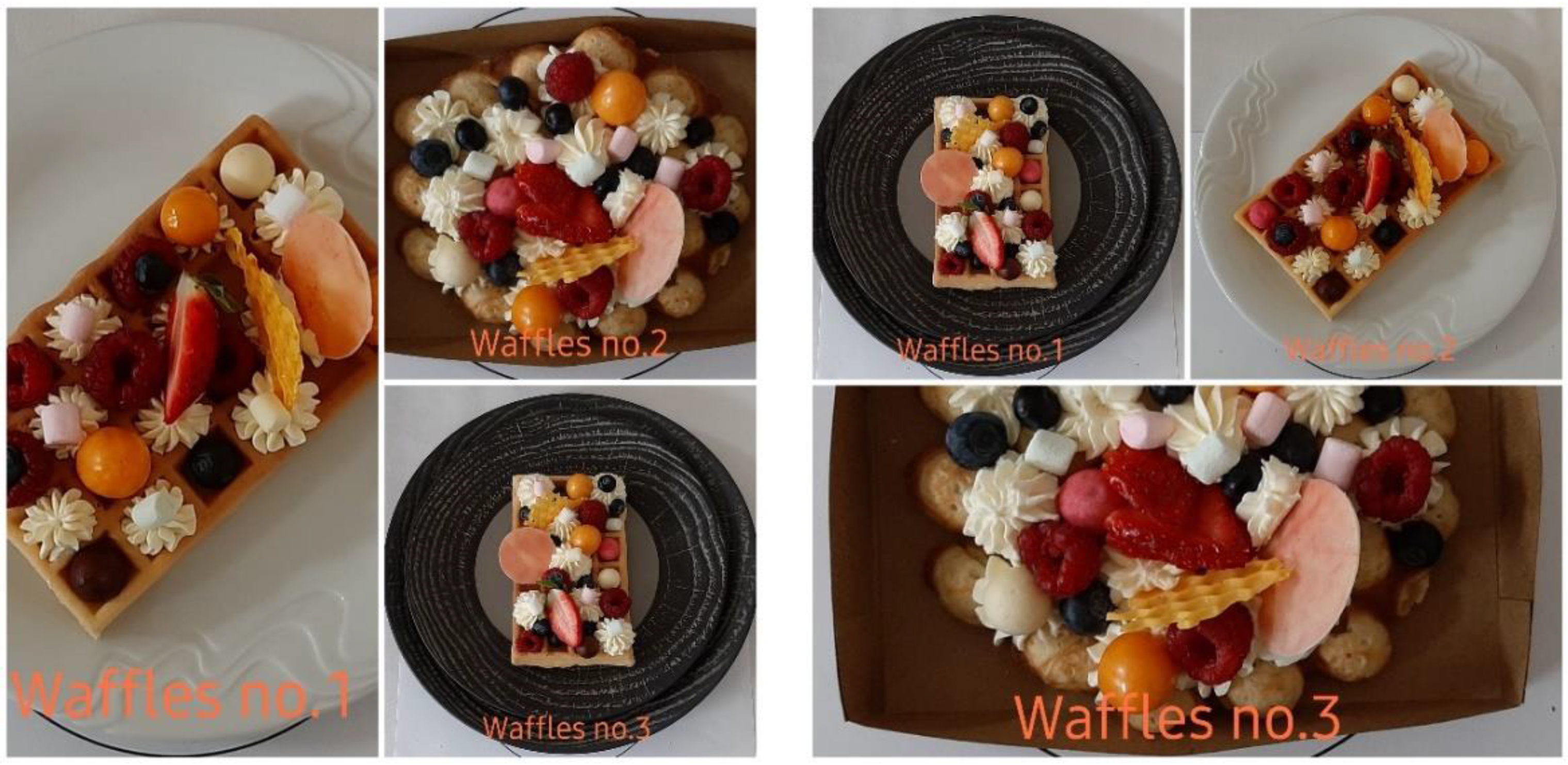
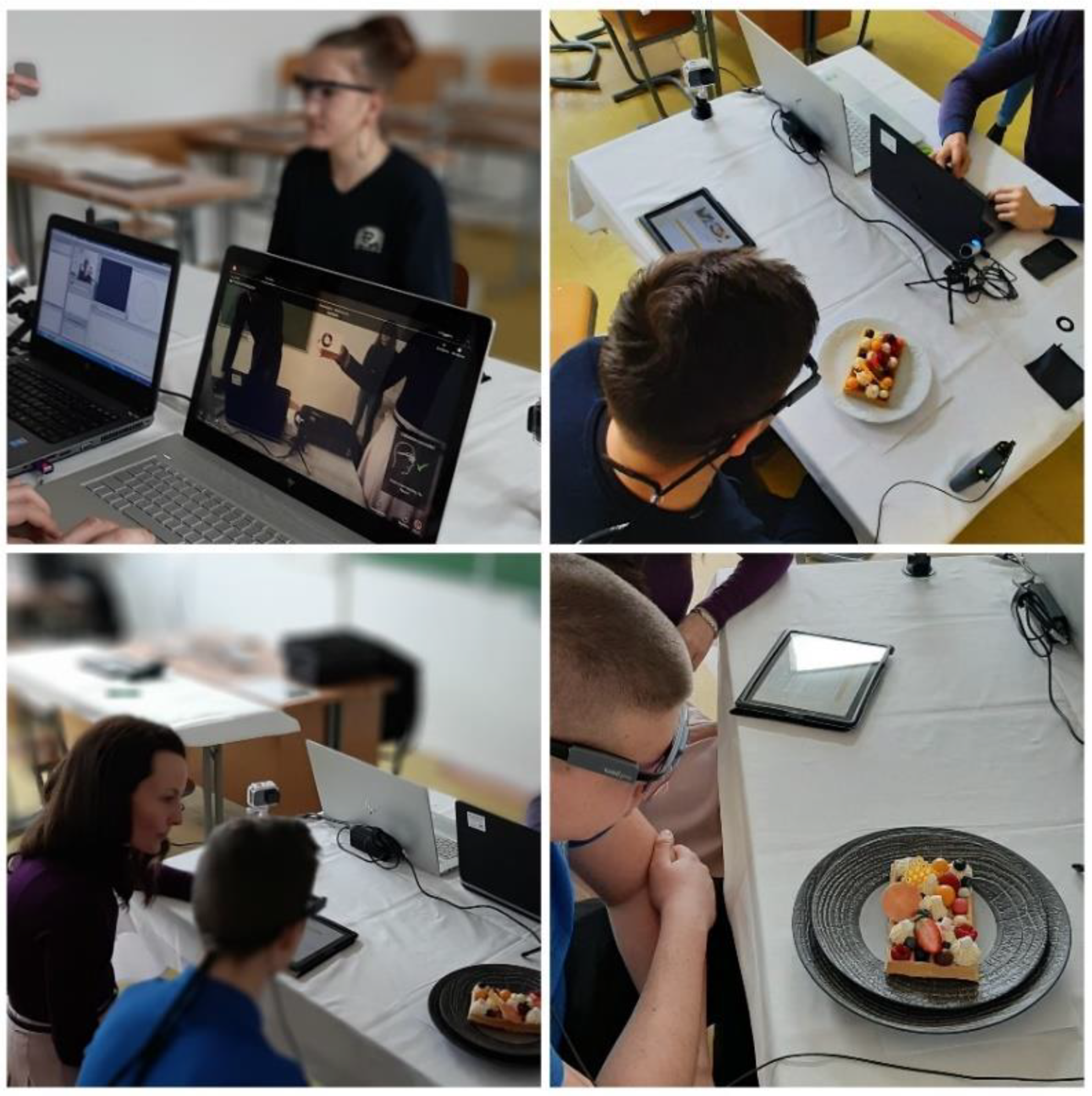
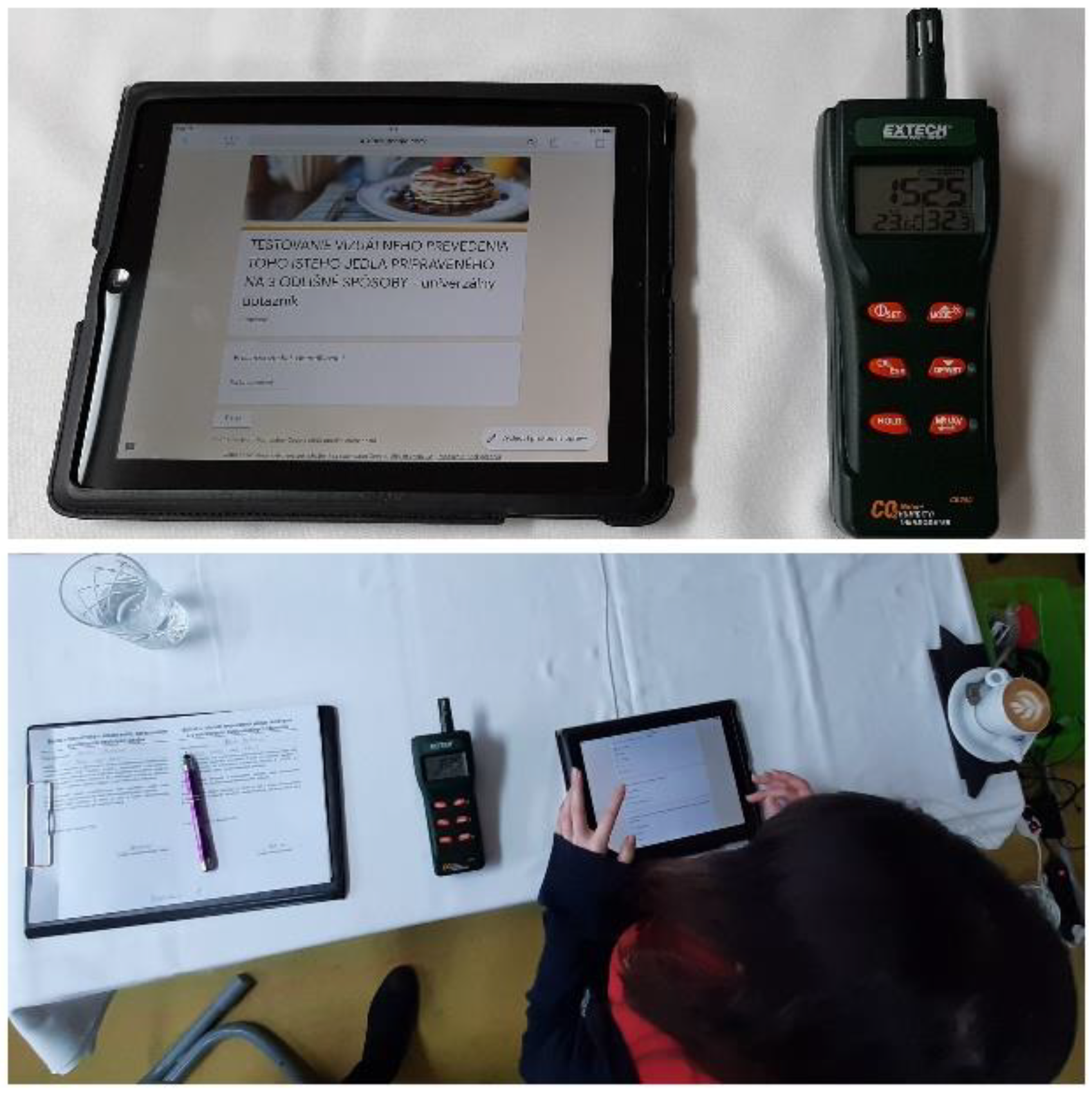
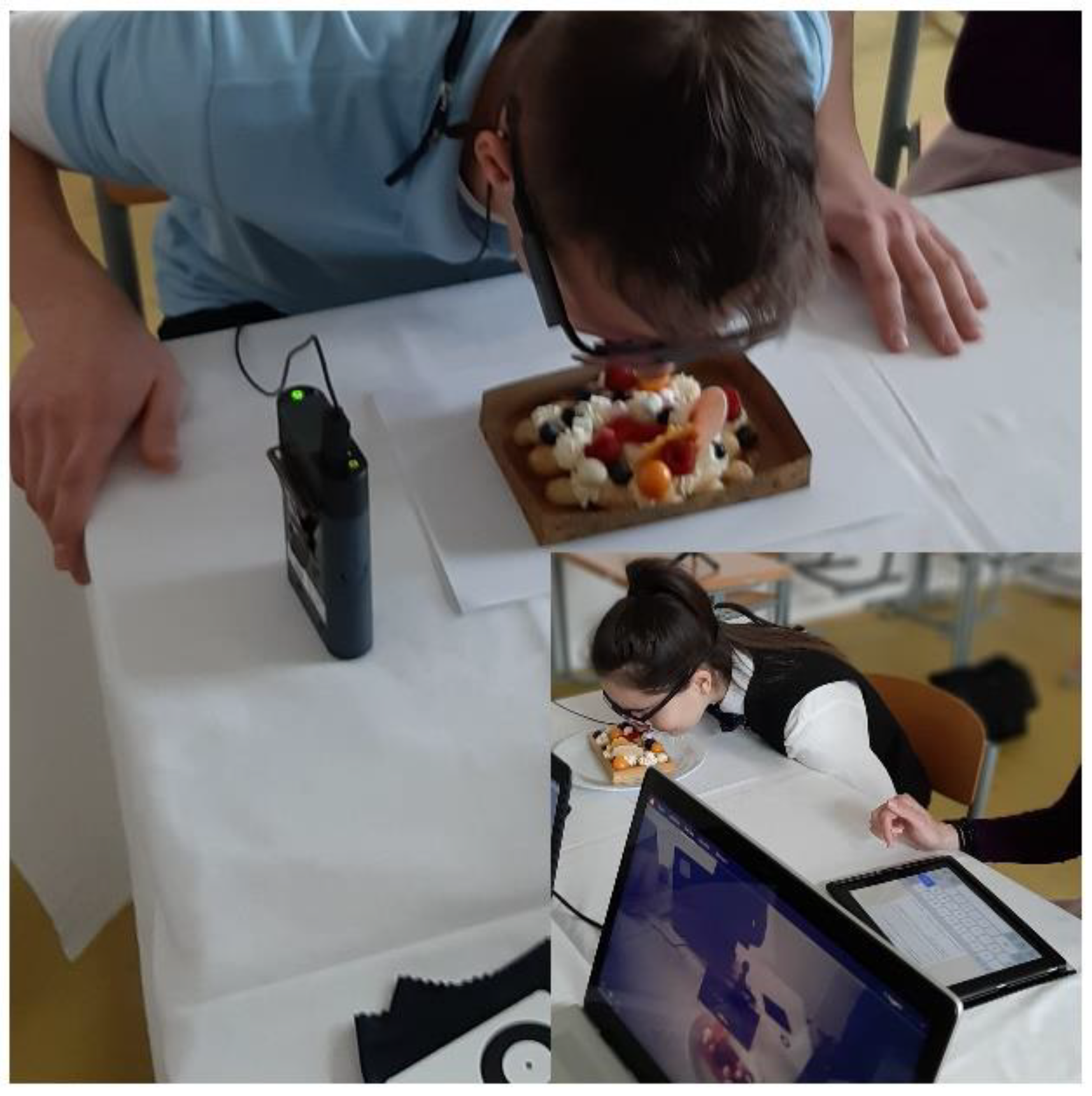
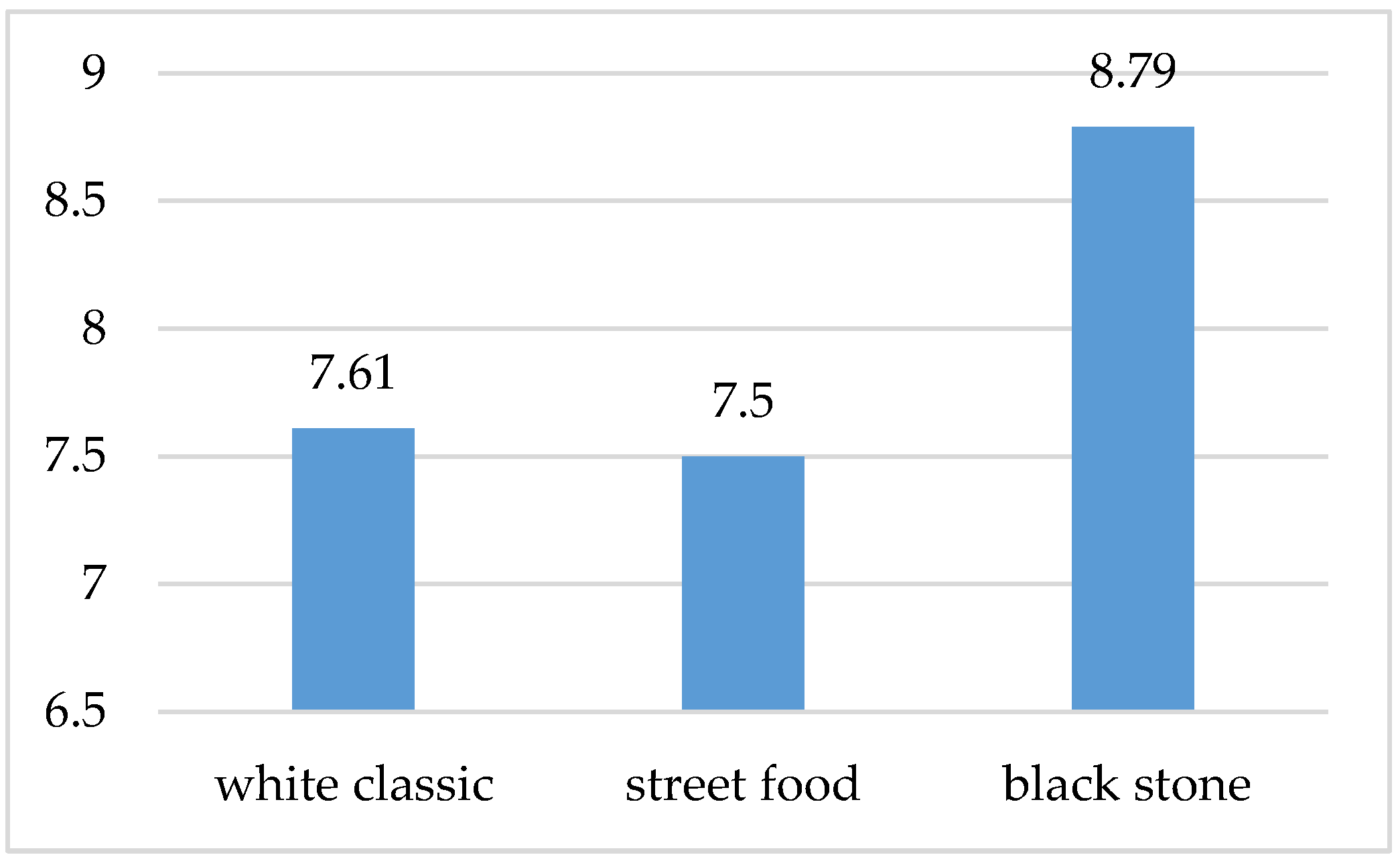

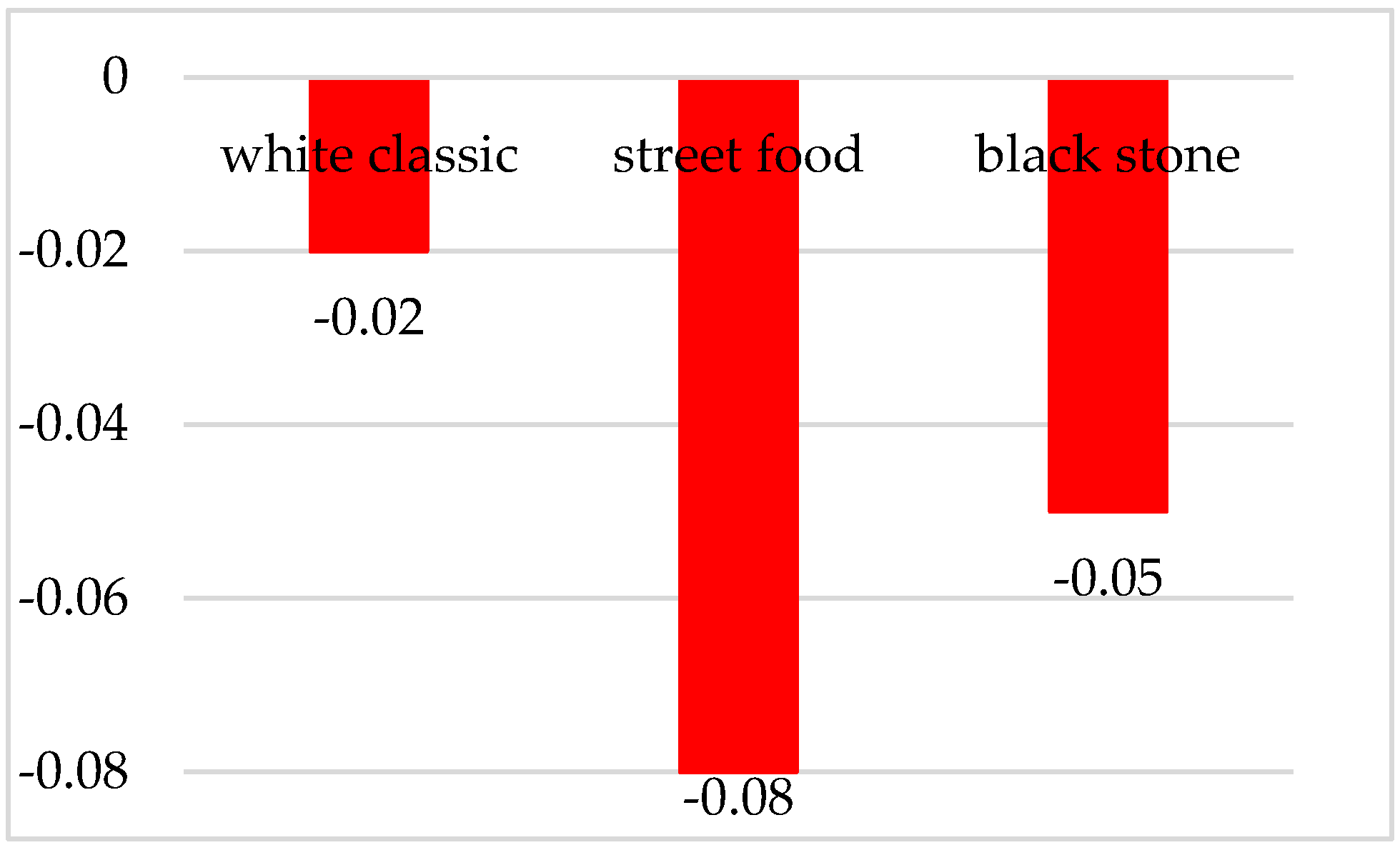
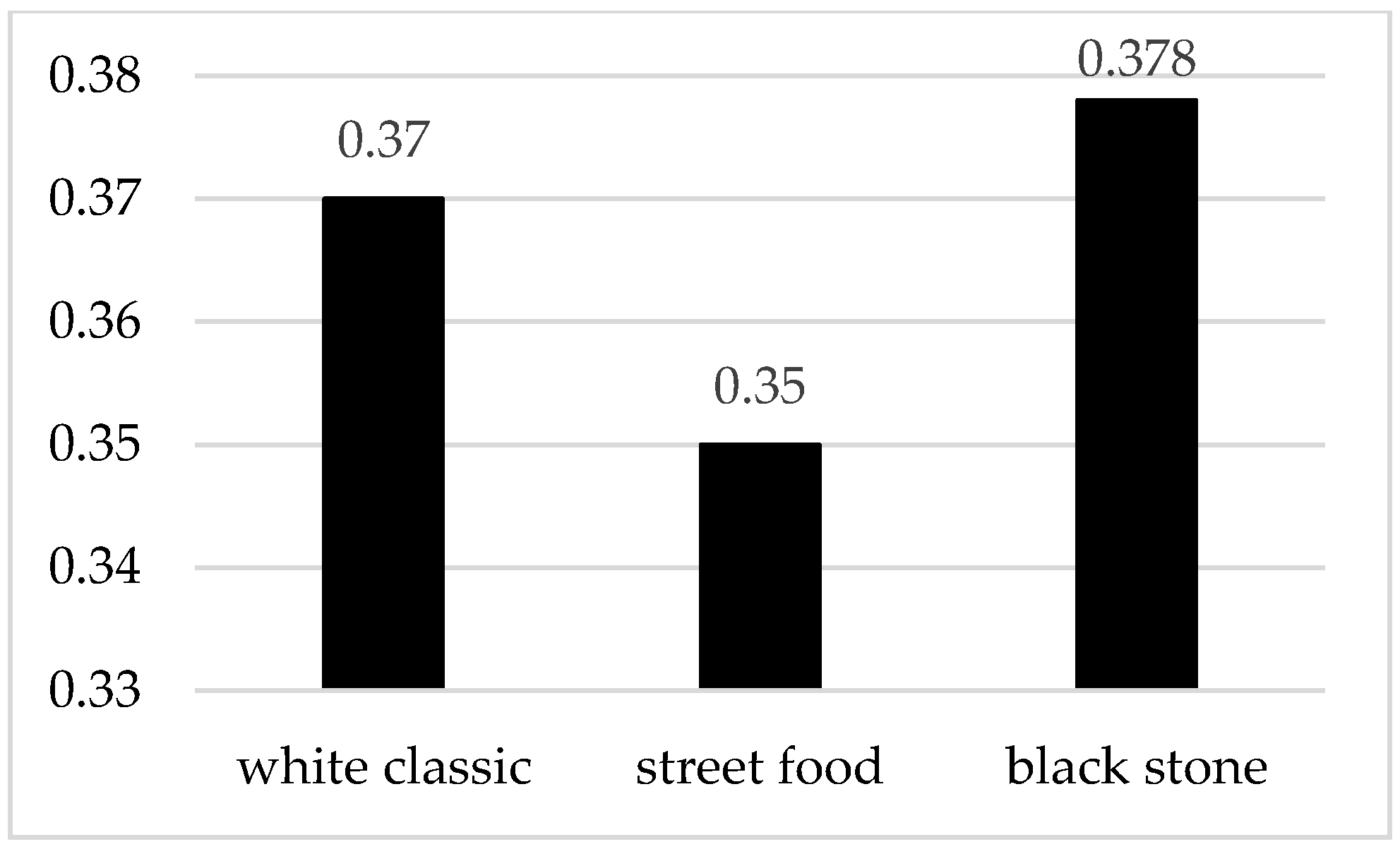
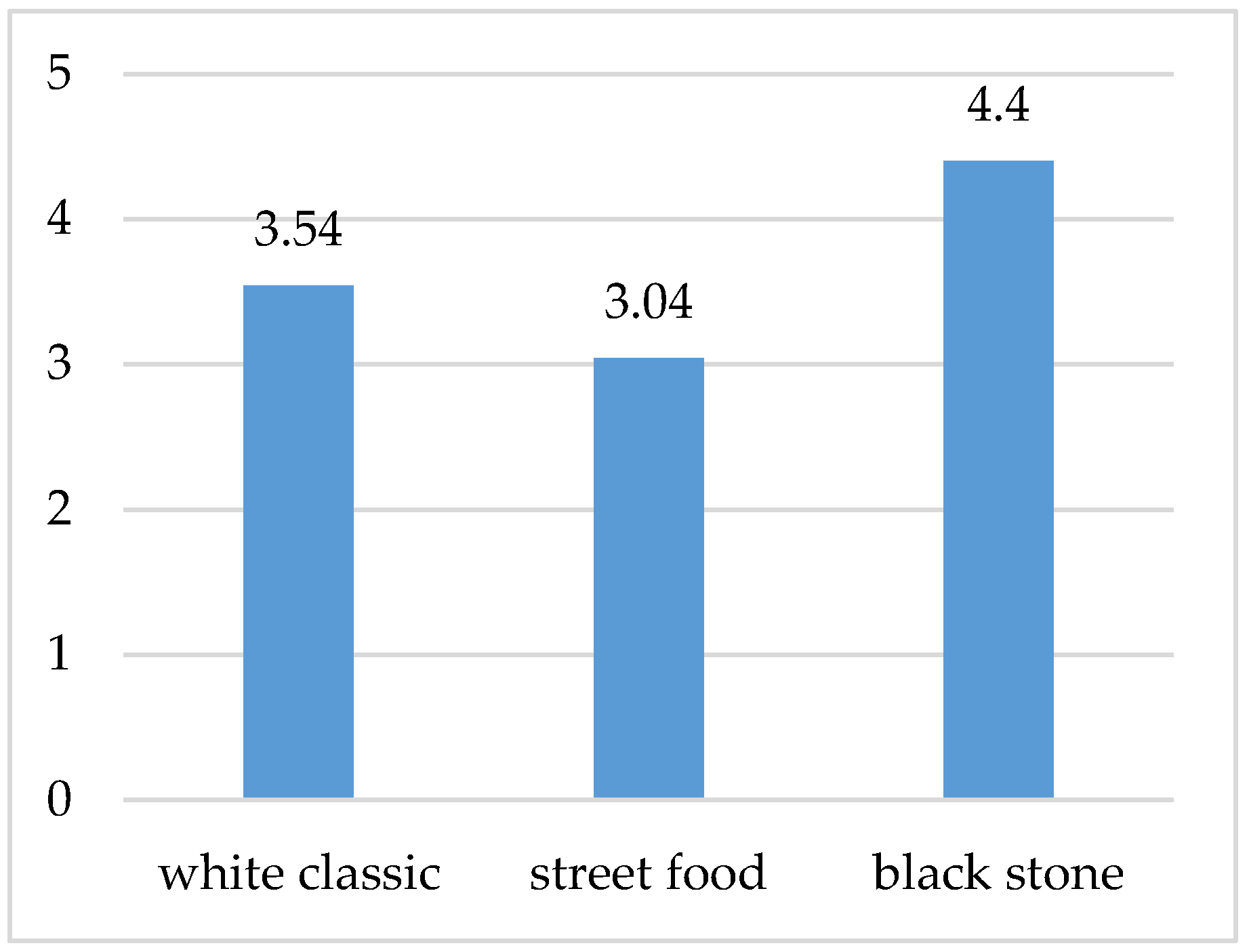
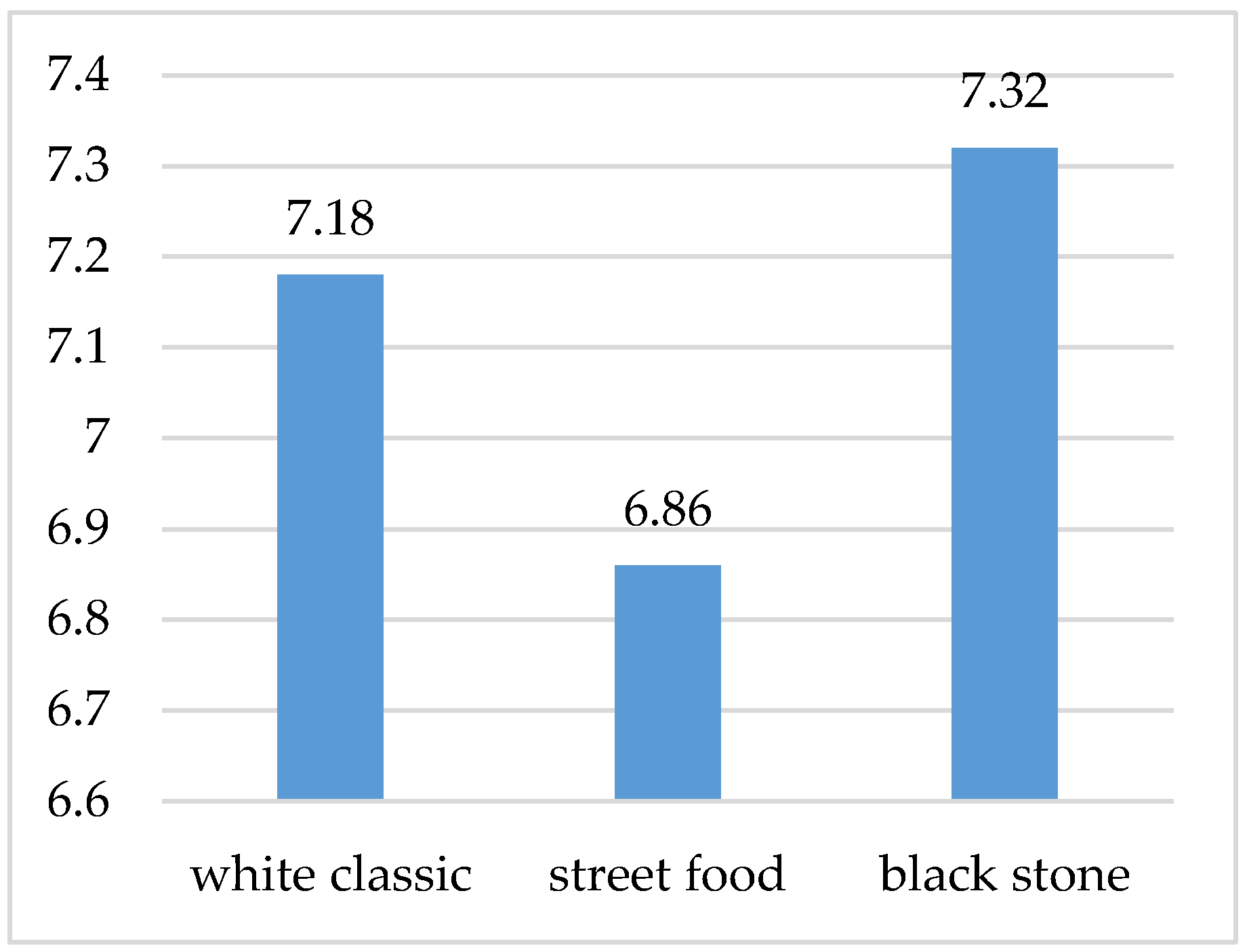

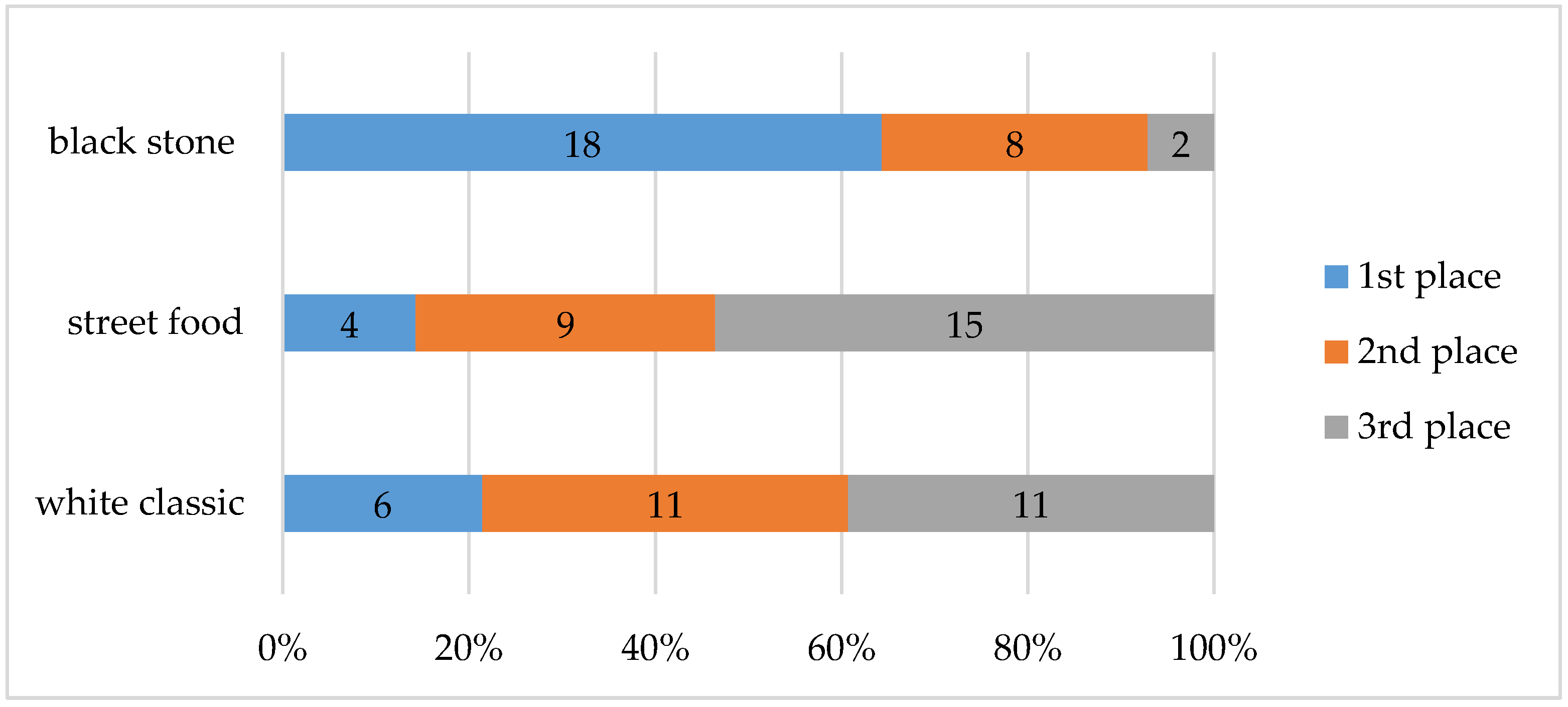
| Element | Factor | Unit | Value Range | |
|---|---|---|---|---|
| Lighting | Intensity | Lux | 280–330 | |
| Chromaticity temperature | K | 3600–4000 | ||
| Noise | Intensity | dB | 24–44 | |
| Air quality | Temperature | °C | 24–25 | |
| Humidity | % | 43 | ||
| CO2 | Ppm | 560–700 | ||
| The Weather | ||||
| Temperature | Humidity | Precipitation (probability) | Character | Pressure |
| 4–5 °C | 41% | 0% | Sunny/clear | 1016 hPa |
| Visual 1 | Visual 2 | Visual 3 | |
|---|---|---|---|
| Visual 3 | H0 | H1 | |
| Visual 2 | H1 | ||
| Visual 1 |
Publisher’s Note: MDPI stays neutral with regard to jurisdictional claims in published maps and institutional affiliations. |
© 2021 by the authors. Licensee MDPI, Basel, Switzerland. This article is an open access article distributed under the terms and conditions of the Creative Commons Attribution (CC BY) license (http://creativecommons.org/licenses/by/4.0/).
Share and Cite
Berčík, J.; Paluchová, J.; Neomániová, K. Neurogastronomy as a Tool for Evaluating Emotions and Visual Preferences of Selected Food Served in Different Ways. Foods 2021, 10, 354. https://doi.org/10.3390/foods10020354
Berčík J, Paluchová J, Neomániová K. Neurogastronomy as a Tool for Evaluating Emotions and Visual Preferences of Selected Food Served in Different Ways. Foods. 2021; 10(2):354. https://doi.org/10.3390/foods10020354
Chicago/Turabian StyleBerčík, Jakub, Johana Paluchová, and Katarína Neomániová. 2021. "Neurogastronomy as a Tool for Evaluating Emotions and Visual Preferences of Selected Food Served in Different Ways" Foods 10, no. 2: 354. https://doi.org/10.3390/foods10020354
APA StyleBerčík, J., Paluchová, J., & Neomániová, K. (2021). Neurogastronomy as a Tool for Evaluating Emotions and Visual Preferences of Selected Food Served in Different Ways. Foods, 10(2), 354. https://doi.org/10.3390/foods10020354





